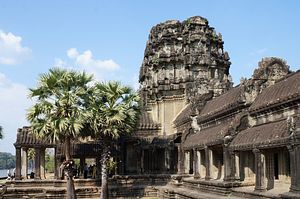Last week, the United States issued an arrest warrant for the flamboyant British expat Douglas Latchford, also known as “Pakpong Kriangsak,” for the looting, sale, and trafficking of Cambodian antiquities into American and European art houses and museums.
Latchford, a muscleman who liked to be seen with the bodybuilders he oversaw as president of the Thailand Bodybuilding and Physique Sports Association, had cultivated a near legendary status in Bangkok. He also took a serious dislike to anyone who challenged his motives. But it was his reputation as a collector of fine antiquities, particularly from Cambodia, that opened the lucrative doors of high society in galleries from Hong Kong to Singapore and London to New York – enabling the octogenarian to indulge in the hedonistic high life of Bangkok. His ability to retrieve those artifacts amid Cambodia’s 30-year-war partly explains his moniker, “Dynamite Doug.”
Now Latchford is in the cross-hairs of the Department of Homeland Security and a District Attorney’s Office in the United States.
The U.S. Attorney’s Office in the Southern District of New York said Latchford was charged with wire fraud, smuggling, conspiracy – each charge carries a maximum sentence of 20 years – and related charges “pertaining to his trafficking in stolen and looted Cambodian antiquities.”
“As alleged, Latchford built a career out of the smuggling and illicit sale of priceless Cambodian antiquities, often straight from archaeological sites, in the international art market,” U.S. Attorney Geoffrey S. Berman said in a statement.
The warrant follows years of legal work, diplomatic negotiations, and operations by the New York Field Office of the Homeland Security Investigations (HSI), which has resulted in the return of rare Cambodian statues dating back to the Angkor Empire.
The statement from the Attorney’s Office said that, through investigative efforts of HSI special agents, three stolen artifacts from Cambodia and one from India, with a total value of $750,000, were recovered and would be returned.
“In addition, an alleged major player in a multi-billion-dollar cultural property transnational criminal network was identified and revealed,” said the statement.
Latchford, 88, remains at large in Thailand, it added. His indictment detailed a long list of alleged crimes beginning in the early 1970s; alleged fraudulent schemes to sell looted art were continuing until as recently as 2012.
“The theft and trafficking of cultural property and priceless national treasures is a global concern. Historical artifacts are living sources of knowledge, objects of worships, and symbols of hope that must be safe guarded for future generations,” HSI Special Agent in Charge Peter Fitzhugh said.
The Cambodian government has complained that many of the statues were stolen during years of civil war, violence, and genocide, including when the country was to laid waste primarily by the Khmer Rouge, who were active in selling rare Angkorian artifacts to fund their war effort.
During this time, Cambodian archaeological sites from the ancient Khmer Empire, such as Angkor Wat and Koh Ker, suffered serious damage and widespread looting. This looting was widely publicized and well-known to participants in the international art market, and looted artifacts usually entered the international art market through an organized looting network.
As the investigation into Latchford unfolds, one can assume it will be watched closely far and wide, including by countries, conservationists, and collectors of major art houses alike.
Luke Hunt can be followed on Twitter @lukeanthonyhunt

































